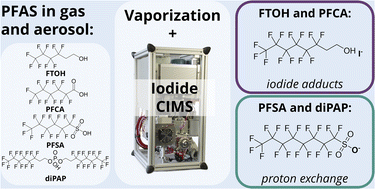Evaluation of iodide chemical ionization mass spectrometry for gas and aerosol-phase per- and polyfluoroalkyl substances (PFAS) analysis†
Abstract
Per- and polyfluoroalkyl substances (PFAS) are a class of ultra-persistent anthropogenic contaminants. PFAS are ubiquitous in environmental and built systems, but very few online methods exist for their characterization in atmospheric gases and aerosols. Iodide time-of-flight chemical ionization mass spectrometry (iodide-ToF-CIMS) is a promising technology for online characterization of PFAS in the atmosphere. Previous work using iodide-ToF-CIMS was successful in measuring gas-phase perfluoroalkyl carboxylic acids and fluorotelomer alcohols, but those are just two of the myriad classes of PFAS that are atmospherically relevant. Therefore, our first objective was to test other sample introduction methods coupled to iodide-TOF-CIMS to evaluate its ability to measure a wider suite of PFAS in both gas and aerosol phases. Using a variety of sample introduction techniques, we successfully measured gas-phase fluorotelomer alcohols (FTOHs), gas and aerosol-phase perfluoroalkyl carboxylic acids (PFCAs), and aerosol-phase perfluoroalkyl sulfonic acids and polyfluoroalkyl phosphoric acid diesters (PFSAs and diPAPs). We also determined iodide-ToF-CIMS response factors for these compounds by introducing known quantities using a Filter Inlet for Gases and AEROsols (FIGAERO). These response factors ranged from 400 to 6 × 104 ions per nanogram, demonstrating low limits of detection. Furthermore, PFAS are a poorly understood diverse class of molecules that exhibit unusual and often unexpected physicochemical properties due to their highly fluorinated nature. Since detection of PFAS with iodide-ToF-CIMS relies on the analyte molecule to either undergo proton transfer or adduct formation with iodide, understanding PFAS behavior during chemical ionization gives rise to a more fundamental understanding of these compounds. Through voltage scanning experiments and DFT calculations, we found that PFCAs and FTOHs readily form iodide adducts, while PFSAs and diPAPs preferentially undergo proton transfer to iodide. Generally, binding energy increased with increasing linear chain length, and PFCAs had stronger binding than FTOHs. Overall, our results suggest that iodide-ToF-CIMS can be used to measure even nonvolatile PFAS such as PFSAs and diPAPs in the aerosol phase in a semi-continuous online fashion.

- This article is part of the themed collection: Chemistry of Atmospheric Pollutants


 Please wait while we load your content...
Please wait while we load your content...